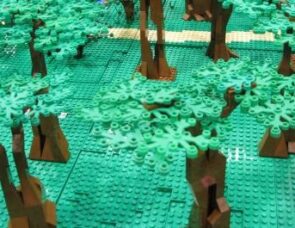How to create a quick 3D map of the Easter story.

Introduction
How can we quickly explain the events of the Easter story in a memorable way? The approach here quickly creates a 3D ‘map’ in the classroom that makes sense of the Easter narrative by showing how the key events and locations relate to each other. It is particularly useful for highlighting discussions about:
- Jesus’ lack of interest in challenging the Roman Empire with his new ‘kingdom’
- The importance of the Jerusalem temple
- The significance of the moment when Jesus prayed in the garden of Gethsemane
Preparation
You will need:
- a large piece of sandy-coloured cloth (to represent the landscape)
- a large number of giant Jenga blocks (or similar) for the walls
- model trees to represent the garden of Gethsemane
- a decorated ‘open’ shoebox lid with a smaller box inside to represent the Jerusalem temple (you can source images online)
- another box (or blocks piled on each other) to represent the Roman Antonia fortress.
Whatever you use, make it possible to set up the whole scene in a minute or less. Placing it on a table usefully brings it nearer eye level, for children to ‘gather around’.
Development
To begin with, familiarise yourself with the shape of the city walls, gates and compass directions of first-century Jerusalem. Most Bibles will contain a map, but a variety of maps are available online – click here for an example.
Take note of the following locations:
- The basic shape of the city walls – a rough oval with the longer section running north to south
- The Jewish temple, on a raised hill inside the city to the east
- The garden of Gethsemane outside the walls near the Lion gate to the east
- The Roman Antonia fortress inside the Antonine gate to the north-east
- Golgotha – where the crucifixion took place to the north outside the walls
Placing the story on the map
Now familiarise yourself with the key moments of the story as it evoles through the week – the names of the different city gates aren’t important in the storytelling, but they will help you to orientate yourself for the key locations.
- Palm Sunday:Jesus’ route into town was probably through the Golden gate or Antonine gate. Note how this meant travelling either directly away from the Roman fortress once he was inside the city, or travelling around three sides of the fortress before entering the outer temple precincts and ejecting the market traders in the Court of the Gentiles around the edge. That must have disappointed many people shouting ‘Hosanna’ to this new ‘Messiah’. The route shows he was not there to throw out the Romans. His business was with the temple and all it stood for.
- Monday to Wednesday: Each day, Jesus continued to visit the temple to teach the crowds, but probably leaving each night to stay elsewhere.
- Maundy Thursday:We don’t really know for certain where the Passover meal took place in the ‘upper room’. Tradition places it in a house inside the walls near Mount Zion to the south-west somewhere inside the walls, near the Zion or Jaffa gate.
- The garden of Gethsemaneis directly outside the Lion or Golden gate, near the temple pinnacle from which the High Priest would eject the sacrificial ram (‘scapegoat’) on the traditional Day of Atonement, carrying the sins of the people. As he prayed in the garden, Jesus must have been conscious of that symbolic act as he considered what was about to happen to him soon. This juxtaposition is not mentioned in the gospels, but the proximity of the two sites is striking – and an interesting detail for children.
- His trial on Thursday nightwas in the palace of Caiaphas the High Priest to the south of the city inside the Dung Gate, then the Council Chamber in the temple, after which he was taken to the judgement hall of the Roman Governor’s house, part of the Roman fortress. Governor Pilate didn’t know what to do with him, so he sent Jesus under guard to Herod’s palace near the Zion gate – who then sent him back.
- The Friday morning:The meeting in front of a large crowd to decide what to do with Jesus would have been outside Pilate’s judgement hall. After the sentence of death was pronounced from there, Jesus had to carry his cross (with others) along winding roads towards the Damascus gate then outside the city to Golgotha (‘Calvary’). His supposed burial place is nearby.
Most of these locations are approximate, so it’s not worth troubling over their exactitude – they are simply visual ‘pegs’ for your storytelling.
Telling the story with children
When teaching about the Easter story, use this resource as a five-minute ‘extra’ to accompany whatever other method you have of relating the key events. It’s best to build up the whole sweep of the story over several sessions, focusing on, for example, Palm Sunday in one session, Maundy Thursday in the second, the trials and sentencing in the third, crucifixion and internment on the fourth, and the resurrection on the fifth. Each succeeding session can quickly recap the narrative from the previous sessions, tying the whole ‘story map’ together. Don’t bother with adding small figures to represent the people. Simply point and tell, moving your fingers from one location to the next.
If you have a computer and projector, you might want to show as background an Internet-sourced image of the great ‘Jerusalem model’ situated in the Israel Museum today, to recreate the locations of these events in fine detail.
Don’t be surprised if children come back to your ‘map’ afterwards for another look. Some might even use it for retelling the story in their own words.

 Download
Download